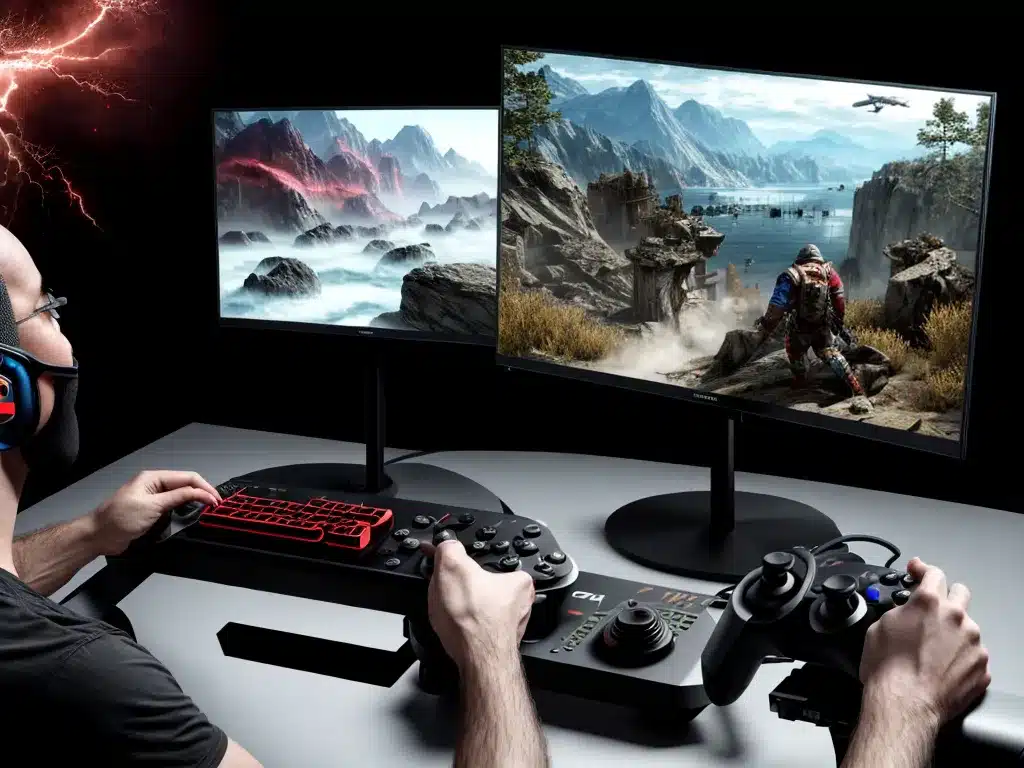
Introduction
With the release of Nvidia’s new RTX 3090 graphics card, 8K gaming has gone from pipe dream to reality. As the successor to 4K resolution, 8K (7680 x 4320) offers 4x as many pixels, leading to unparalleled visual fidelity. However, running games at this resolution requires serious graphical horsepower. In this article, I’ll discuss how recent advances in GPU technology are enabling 8K gaming and reshaping the limits of high-resolution graphics.
The Rise of 8K Gaming Displays
The first step to 8K gaming is having a monitor that can display an 8K resolution. While 8K TVs have been available for a few years now, 8K gaming monitors are still relatively new. The first viable 8K gaming monitors arrived in late 2020, like the ASUS ROG Swift PG32UQX, a 32-inch model with a 144Hz refresh rate.
Since then, more monitors have arrived supporting 8K at even higher refresh rates. In 2022, we’re starting to see monitors like the Acer Predator X32 reach 160Hz refresh rates at 8K resolution. This enables much smoother motion clarity while gaming. As panel and manufacturing technology improves, 8K monitors will become more affordable and higher performing.
The Power Required for 8K Gaming
Driving 8K resolution requires a massive amount of graphics processing power. To put the demands of 8K into perspective, 8K has 4x as many pixels as 4K resolution (3840 x 2160). This means an 8K GPU needs to process 4x the pixel data per second compared to 4K.
To achieve strong 8K gaming performance (60+ FPS at high settings), GPUs need to have very high levels of performance:
-
High core counts – More cores allow the GPU to render many pixels simultaneously. The RTX 3090 has 10496 CUDA cores.
-
Extreme memory bandwidth – 8K textures require fast VRAM. The 3090 provides 936 GB/s of bandwidth with its 24GB GDDR6X VRAM.
-
Power efficiency – Efficient power draw allows clock speeds to scale. The 3090 has a 350W TDP.
-
Advanced architectural design – Improvements like RT and tensor cores accelerate specialized calculations.
Only the most powerful modern GPUs like the RTX 3090 can realistically handle 8K gaming. And even then, performance is limited to around 60 FPS. Gamers demand high frame rates for smooth gameplay, so there’s still room for improvement.
How Frame Rates Are Improving
While 60 FPS is playable, many PC gamers prefer higher frame rates like 144+ FPS for competitive games or to take advantage of high refresh rate monitors. So how can frame rates improve? Here are some technological advancements that will push 8K gaming performance higher:
-
Newer GPU architectures – Nvidia’s next-gen RTX 40-series will bring major performance gains via new architectures. Rumors point to 2-3x faster speeds compared to 30-series cards. This brings the possibility of 100+ FPS 8K gaming.
-
Multi-GPU setups – Using two or more GPUs via SLI/NVLink can combine processing power. Dual 3090s deliver over 100 FPS in some 8K games. Support and scaling isn’t perfect yet, but multi-GPU is coming back.
-
Upscaling techniques like DLSS use AI and tensor cores to boost frame rates. By rendering at a lower resolution then upscaling, big performance gains are possible. Games with DLSS show up to 2x higher 8K FPS.
-
New display specs – Monitors capable of 8K at 240Hz or even higher will arrive, enabling ultra-smooth 8K gaming once GPUs catch up.
Pushing Graphics Fidelity Further with Ray Tracing
Beyond just resolution, next-gen gaming will see graphics fidelity improve via real-time ray tracing. This advanced lighting technique was introduced with Nvidia’s RTX cards and provides far more realistic lighting, shadows, reflections and other effects.
To handle ray tracing’s intense demands, RTX cards have dedicated ray tracing and AI tensor cores. When combined with high resolutions, ray tracing showcases their full visual potential.
For example, in Cyberpunk 2077 with Psycho ray tracing enabled at 8K resolution, the level of detail is simply jaw-dropping – from accurate shadows and reflections to complex particles and lighting. Gamers need serious GPU power to experience both 8K and ray tracing, but the visual results are unmatched.
Conclusion
With the arrival of HDMI 2.1 graphics cards and monitors, 8K gaming has become a reality. While current GPUs can only provide around 60 FPS, rapid advancements in graphics technology point to high frame rate 8K gaming in the near future. Paired with stunning real-time ray tracing effects, 8K gaming will provide photorealistic levels of fidelity and usher in a new era of high-resolution gaming. But these cutting-edge visuals require serious GPU horsepower – lucky for us, graphics cards continue to evolve and push the limits.












